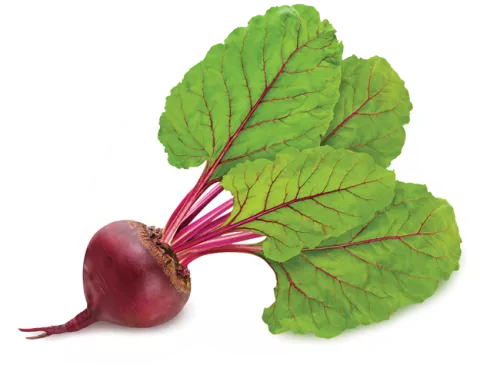Growing
Beets grow best in fertile, well-drained soils. Compost may be added to improve fertility. Sow seeds from midspring through mid-July. Best quality beets are grown under mild, cool conditions.
Sow seeds about 1 inch apart, ½ inch deep, in rows 12 to 18 inches apart. Thin seedlings to 2 inches apart.
Seeds may be sown at two- to three-week intervals to provide a steady supply of greens and tender roots throughout the season. Irrigate when needed to produce smooth, bright roots.
Harvesting
Harvest beets when they are the size of a golf ball or larger. Beets with a diameter larger than 3 inches may be tough, fibrous and woody. Most varieties mature 50 to 70 days after sowing. Beets will not tolerate heavy frosts.
Storing
Root crops such as beets can be left in the ground until the soil freezes. Harvested beets may be stored in the refrigerator in a plastic bag for several weeks. Store them in a spot separate from raw meat or poultry to prevent cross contamination. Cool, dry places in your house such as the basement, garage, root cellars or a dark and cool closet can work for storing beets.
Save beet seeds by keeping them in a cool, dry place. Beet seeds could remain viable for up to five years.
Preparing
Beets can be eaten fresh, pickled, added to salads or roasted in the oven. Remove the beet tops, leaving about an inch from the stem. Do not remove the taproot of the beet to prevent color loss while cooking. Rinse beet greens and refrigerate for later use in a salad or stir fry, if desired.
Heat the beets in an oven or boil them before removing the skins. Boil 25 to 30 minutes for small beets and 45 to 50 minutes for medium beets. Roots and stems may be removed after the beet is cooked.
Canning
Root vegetables such as beets must be preserved using a pressure canner because of their low acid content. Beets must be pickled with vinegar if a water bath is used. Recommended varieties for canning include Detroit Dark Red, Cylindra and Ruby Queen. Pickled beets may be processed in a boiling water-bath canner.
Freezing
Cook small beets 25 to 30 minutes and medium beets 45 to 50 minutes. Cool, peel and cut into slices or cubes. Package, seal and freeze in freezer containers/bags.
See www.ag.ndsu.edu/food for more information about food preservation.
Nutrition
One 2-inch-diameter beet: 35 calories, 1 g protein, 0 g fat, 8 g carbohydrate, 2 g fiber, 64 mg sodium and 266 mg potassium. Beets also are good sources of folate, phosphorous and vitamin A.
Recipes
Key to abbreviations
c. = cup
tsp. = teaspoon
Tbsp. = tablespoon
oz. = ounce
lb. = pound(s)
g = gram
mg = milligram
Beet Hummus
5 small cooked beets
2 (15-oz.) cans chickpeas, drained and rinsed
¼ c. tahini (sesame seed paste)*
2 cloves garlic
¼ c. lemon juice
2 Tbsp. canola oil or other cooking oil
¼ tsp. cayenne pepper
½ tsp. cumin
¼ tsp. black pepper
Sunflower seeds
Parsley
Preheat oven to 400 F. Drizzle beets with olive oil. Wrap the beets and garlic together in foil. Place on baking sheet and roast in oven 30 to 40 minutes until fork tender.
When cool, peel the beet skins under running water. Slice each beet in half and place it in a blender or food processor. Add roasted garlic, chickpeas, tahini, canola oil and lemon juice. Add cayenne, cumin or coriander spices if desired. Blend until smooth. Garnish with sunflower seeds and parsley. Serve with raw vegetables or crackers.
Makes 13 servings. Each serving has 110 calories, 6 g fat, 12 g carbohydrate, 4 g protein, 3 g fiber and 100 mg sodium.
*Tahini may be found in the specialty foods section of many grocery stores.
Pickled Beets
7 lb. (2- to 2½-inch-diameter) beets
4 c. vinegar (5% acetic acid; note ingredients on container)
½ tsp. canning or pickling salt
2 c. sugar
2 c. water
2 cinnamon sticks
12 whole cloves
4 to 6 onions (2 to 2½ inches diameter), if desired
Trim beet tops, leaving 1 inch of stem and roots to prevent bleeding of color. Wash thoroughly. Sort for size. Cover similar sizes together with boiling water and cook until tender (about 25 to 30 minutes). Caution: Drain and discard liquid. Cool beets. Remove roots and stems and slip off skins. Slice into ¼-inch slices. Peel and thinly slice onions. Combine vinegar, salt, sugar and fresh water. Put spices in a cheesecloth bag and add to the vinegar mixture. Bring to a boil. Add the beets and onions. Simmer for five minutes. Remove the spice bag. Fill jars with beets and onions, leaving ½ inch of head space. Add the hot vinegar solution, allowing ½ inch of head space. Adjust the lids and process for 30 minutes in a boiling water-bath canner at altitudes of 0 to 6,000 feet.
Variation: Pickled whole baby beets. Follow the above directions but use beets that are 1 to 1½ inches in diameter. Pack whole; do not slice. Onions may be omitted.
Yield: About eight pints. One ounce of pickled beets has 20 calories, 0 g fat, 0 g protein, 5 g carbohydrate, 0 g fiber and 140 mg sodium.
Funding for this publication was made possible by the U.S. Department of Agriculture’s Agricultural Marketing Service through grant AM190100XXXXG028. Its contents are solely the responsibility of the authors and do not necessarily represent the official views of the USDA.
For more information on this and other topics, see www.ndsu.edu/extension.


